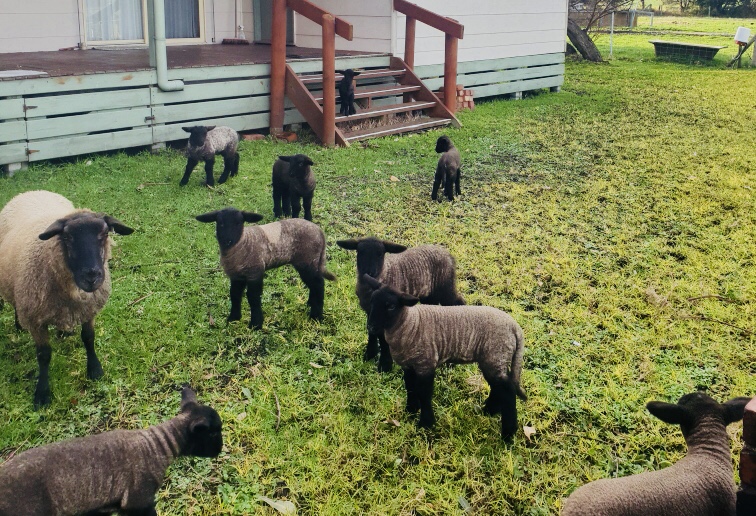Utilising animals in farming practices is not a new concept, however it hasn’t been as common as it was prior to the industrial revolution when machinery made certain jobs much faster. Nowadays the practices that incorporate animals into the small farm system are becoming more popular again. We like to think of it as a holistic approach to farming, and it is the essence of what we are trying to build: a system where everything in it has a purpose (often several purposes) and works together to keep the cycle of the farm running.
Pigs
Pigs are probably the most important animal we have on the farm. They make our sustainability and organic goals a possibility. Here is a summary of the many roles our pigs are playing:
Tractors: Rather than ploughing our fields and overturning the bugs and microbes that are working hard under the surface, we’ve chosen to shallow till the earth instead. This method loosens the top soil for planting our vegetables without disturbing the biodiversity underneath too much. Pigs are perfect for this job, as they not only eat down the grass and weeds, but their powerful noses root around in the earth for critters, breaking it up nicely. Pigs are much lighter than actual tractors though, so they don’t compact the earth, and they are completely fossil-fuel free!
The pigs are free range in an area of pasture the size of around two netball courts.
Waste disposal: Pigs love being out on pasture, and can certainly gain a lot of their nutrients this way. However they’re also large hungry animals. Our piglets could eat all day long as they grow. But this presents another great solution to a problem that will inevitably arise in vegetable production. Any excess or imperfect produce we grow can feed our animals, particularly the pigs. Our kitchen scraps can also go to the pigs, provided we don’t feed them meat (agricultural regulations).
Fertiliser: Pig manure contains many nutrients that are essential for plant growth. As our pigs dig up our pasture they deposit their droppings, to mix with the earth we plant our veggies in. Completely organic, no bought-in fertiliser required.
Food: Yes, we are a meat producing farm, and we feel privileged to be able to consume meat that we have raised ourselves, knowing exactly what those animals have been fed, how they’ve been treated, and how well they have lived.
On top of all the benefits pigs bring to our farm, they’re actually rather easy to care for (if you know how). Aside from the basic requirements any animal needs (food, water, disease/parasite prevention), they’re easy to contain (we use movable posts and a couple of strands of electric tape, which they know not to touch once they’ve tested it), and shelter (it took us less than an hour to build the house pictured below). They are very intelligent and curious though, so we like to give them environmental enrichments in their paddock as well; so far, a collection of logs and a few piles of hay seem to be doing the trick. Rotational grazing also prevents boredom – once the pigs plough through an area of pasture, we move them onto fresh pasture. This also helps with their health management.
Sheep
We never actually intended to raise sheep in the beginning. Getting sheep was one of the decisions we made when health issues impacted our farm planning. The grass was getting out of control, and we needed some low maintenance lawn mowers.
Where the pigs are our intensive digging machines in the market gardens, the sheep maintain the grass around the house and sheds, as well as the larger fields that are having a rest from grain crops. Being able to look out the window and watch the sheep and lambs grazing is not only a pleasure for us but will be for future guests of our B’n’B.
Similarly to the pigs though, when the time comes these animals will also supply us with quality meat that we know has been ethically raised. We also plan to find creative uses for their wool when shearing time arrives. Currently we’re thinking insulation for the barns – or maybe I’ll finally learn to spin my own yarn…
Poultry will play a big part on the farm as well, but since we only have a small home flock for now, we’ll cover the birdlife in a future blog.
We’ve chosen to incorporate animals into our system to reduce our reliance on vehicles and machinery. Vehicles depreciate, break down, and use non renewable fossil fuel to keep running. Whereas our livestock can breed and replace themselves over time, and the fuel they consume comes in the form of natural product we’ve produced ourselves (or sourced locally). Of course, animals can (and do) get sick from time to time, and require care to stay in good condition, but the reward of working with these fun and beautiful creatures far outweighs the speed of machines (for us anyway!).
I hope that some of the photos in this post convey the personality and character of the animals that bring us so much joy. This is merely an overview of what we’re doing with them, we could go into other complex details here, but there’s plenty of that good stuff in books and on the internet already for those who want to learn more about the role of animals in regenerative farming.
We have plans for more animals in the future, but you’ll have to wait to find out about them…









